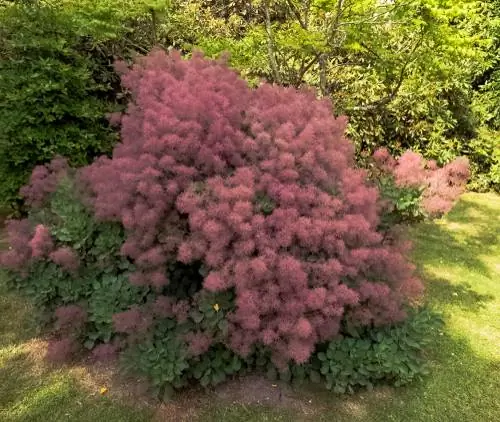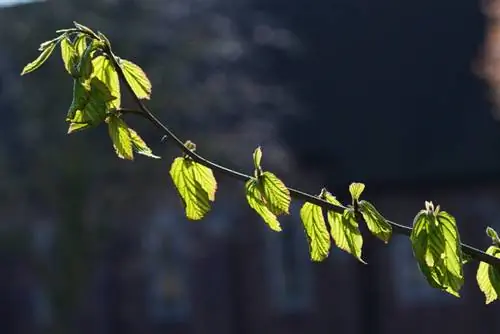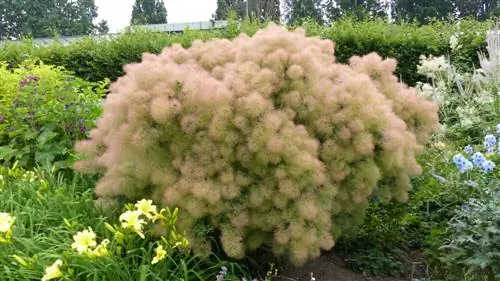- Author admin [email protected].
- Public 2023-12-16 16:46.
- Last modified 2025-06-01 06:02.
The wig bush combines unique pom-pom fruits and furious autumn colors with extensive growth. These characteristics raise questions about the right cut. This tutorial highlights all options for expert pruning care for Cotinus coggygria. How to properly cut a wig bush.
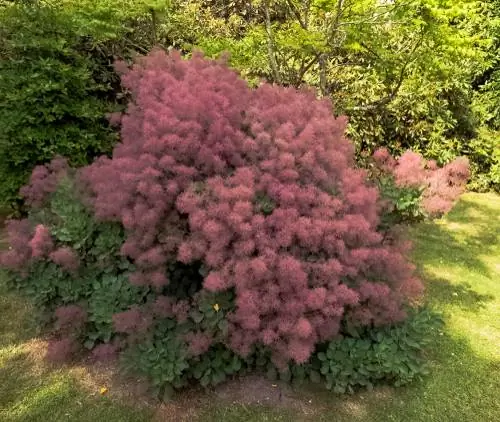
How should you properly prune a wig bush?
To properly prune a wig bush, carry out a pruning pruning in spring, a thinning pruning every 1 to 3 years in late winter, a topiary pruning for intensely colored leaves in spring or a rejuvenation pruning when it ages in late winter, depending on your needs.
Occasions and dates for a cut at a glance
The wig bush is one of the illustrious circle of ornamental trees that can safely do without pruning. An annual shape and thinning cut is also not necessarily part of the care program. Nevertheless, there are various occasions that make it useful to pick up scissors and a saw. The following table gives you all the options for cutting the wig tree:
| Cut style | Target | Period/Occasion | Appointment |
|---|---|---|---|
| Build-up cut | controlled growth, regulation of spread | from the 2nd year | in the spring before budding |
| Blending cut | Preservation of vitality, flower and fruit decoration | every year or every 2 to 3 years | in late winter until March 1st |
| Topiary | Promotion of young, intensely colored leaves | from the 2nd year or from reaching the desired height | before budding |
| Rejuvenation cut | rebuilding an aged bush | when aging due to neglected pruning care | in late winter until March 1st |
| pruning | Compensation for lost root volume | after transplanting | immediately after the change of location |
For home gardeners with a penchant for self-tied dry bouquets and a knack for imaginative arrangement creations, there is another cutting option. When the branches boast their fluffy wigs in autumn, the most beautiful shoots can be cut without hesitation.
Instructions for a built-up cut
As a solitary plant, a wig bush shows off its most beautiful side and does not require any pruning. In a small garden or when combined with other ornamental trees to form a decorative group, the type of cut comes into focus. As part of a well-thought-out upbringing, you set the course for controlled growth with a limited number of scaffolding shoots. This cutting measure also dampens the urge to spread at the beginning because it is difficult for prostrate runners to form. This is how you can create an exemplary build-up cut:
- In the spring of the 2nd year, select the 5 to 7 strong ground shoots to form the framework
- Cut off excess and weak ground shoots at the base
- Do not shorten the scaffolding shoots in order to preserve the flowers and fruit heads
If the selected scaffold shoots with numerous side branches get in each other's way, please do not cut off the shoot tips. Rather, remove the weakest and most unfavorably positioned side shoots. With this cut you can slim down the wig bush without affecting its natural shape.
Instructions for the thinning cut
The most common type of pruning on the wig bush focuses on removing dead or unfavorably positioned shoots. The aim is an airy, loose growth of ground shoots and their branches. If a wig bush can develop freely in its location, thinning is usually recommended at intervals of 2 to 3 years. How to do it professionally:
- Clear out dead wood
- Arching overhanging tips lead to young, vertical shoots
- Cut back or remove shoots that are directed towards the interior of the bush and grow crosswise
- Cut down lying branches that are rooted in the ground at the base
The key to success in pruning care is a targetedslimming of the wig bush without disturbing the annual shoots with scissors (€14.00 on Amazon). You can identify the valuable young wood from the previous year by its unbranched, upright growth. The image below shows the correct procedure.
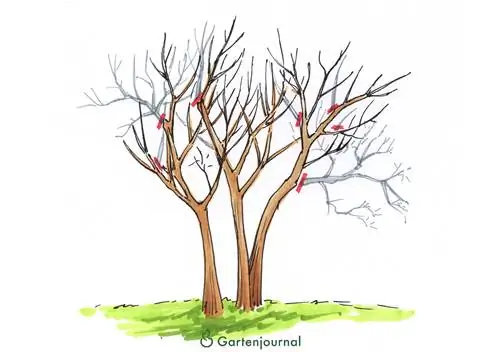
Dead and inward-facing shoots are thinned out. Overhanging and heavily branched branches are diverted and slimmed down. Annual branches bear the most beautiful fruit clusters and are spared from thinning.
Topiary promotes bright leaf decorations
Some of the most beautiful varieties of the wig bush shine with intensely colored decorative leaves. The premium variety 'Royal Purple' impresses with black-red leaves. 'Golden Spirit' looks magnificent with its yellow-gold foliage. The younger the leaves, the more intense the color. Astrong pruningin spring ensures that shoots grow back throughout the summer and continually sprout new,color-intensive leaves.
You can either start cutting in the second year or wait until the wig bush has reached the desired height. This is how a cut promotes the luminosity of the leaves:
- In late spring, cut back all shoots to 30 to 100 cm
- Place the pruning shears 3-5 mm above an outward-facing leaf bud
- In addition, from the 5th year onwards, completely cut off the 2 to 3 oldest scaffold or ground shoots
- Optionally cut back this year's growth after St. John's Day (June 24th)
By picking up the scissors again at the end of June/beginning of July, you can use the second leaf shoots for a colorful end to the year for your wig bush. Provided that the weather conditions are suitable, the ornamental tree sprouts again in late summer with freshly colored, young decorative leaves. Before the leaves fall, the color festival ends in warm, autumnal colors.
Thedisadvantageof this pruning care lies in theforegoing the autumnal fruit clusters A wig bush had already put on its flower buds the previous year. With every cut of the annual shoots, the flowering plants for this year's season are destroyed without replacement.
Excursus
Vitality Test
A wig bush often does not produce its leaves and flowers until mid-May to early June. This growth behavior leads the home gardener to remove a shoot as dead wood, even though it is still full of life. With aVitality Test you can avoid this fallacy. Scrape off some of the bark on the branch in question. If light to green tissue emerges, the shoot is not a case for scissors or saws. However, if you uncover brown-colored, dry tissue, it is actually dead wood.
Rejuvenate the wig bush - this is how it works
Without a thinning cut, a wig bush ages faster. There are hardly any young ground shoots left that can replace old scaffold shoots. In the dense network, the branches shade each other, so that the weakening of photosynthesis causes the shoots to go bald. The abundance of flowers and fruit decoration are visibly decreasing. With a courageousrejuvenation cutyou can restore the well-groomed appearance andrevitalize the shrub as a whole. How to proceed correctly step by step:
- Saw off all dead ground shoots at the base
- Aged scaffold shoots with overhanging brooms lead to a young side shoot below
- Select the desired number of new scaffold shoots from among young ground shoots
- Remove excess, weak ground shoots
The image below demonstrates how to professionally rejuvenate an old wig bush. Apart from the procedure, the choice of date is of particular importance. According to the Federal Nature Conservation Act, radical pruning measures on trees are permitted between October 1st and March 1st. This exception only applies if it is ensured in advance that there are no wild animals in the woods.

When rejuvenating the wig bush, ground shoots are only removed if they are actually dead. Aged scaffold shoots should be diverted to a young side branch in the lower area.
Change of location requires targeted pruning
The wig bush thrives as a heartroot with a root system that goes deep and wide. Compared to shallow-rooted plants such as forsythia or pipe bushes, the wig tree finds it difficult to root again after a change of location. Within the first five years there are still quite good prospects of successfully replanting the ornamental tree. The risk of failure is significantly reduced if pruning compensates for the lost root volume. This is how transplanting and cutting go hand in hand:
- Dig up the wig bush with as much root volume as possible and plant it in the new location
- Cut back all shoots by a third to half
- Make each cut a short distance from a bud or a sleeping eye
Determine the extent of pruning so that at the end the balance between underground and above-ground growth is restored.
Frequently asked questions
Is the wig bush poisonous?
Botanists assign the wig bush to the Sumanaceae family (Anacardiaceae). Therefore, the ornamental tree is distantly related to nasty plants, such as the dreaded poison ivy. It is therefore to be feared that the plant sap from a wig bush is not completely harmless. As a precaution, sensitive people with a pronounced susceptibility to allergies should wear gloves when caring for cuts.
How hardy is a wig bush really?
Competent tree nurseries offer the wig tree for all gardens from winter hardiness zone 6 a. This categorization implies frost resistance down to - 23.3 degrees Celsius. However, this value should only be viewed as a guideline. Newly planted young bushes require light winter protection in their first two years. In a pot, a wig bush will not get through the cold season unscathed without a translucent hood and a warming winter coat made of fleece.
My wig bush doesn't bloom or wear wigs - why is that?
The most common reason for the loss of summer flowers and autumn wig fruits is an incorrectly chosen cutting time. A wig bush produces the buds for the next flowering period the previous year. If pruning is done in spring, most of the flower buds will fall victim to it. Limit pruning care to thinning pruning in late winter. Do not cut back annual shoots. Branches that are too long and arch overhanging lead you to a young side branch.
The 3 most common cutting mistakes
The good-natured pruning tolerance of a wig bush cannot prevent a disappointing result if the gardener makes one of the following mistakes. This table tells you the 3 most common mishaps in pruning care and gives practical tips for regulation or prevention.
| Cutting errors | Result | Correction/Prevention |
|---|---|---|
| never photographed | Aging, fewer and fewer flowers and wigs | Rejuvenation cut, then a thinning cut every 1 to 3 years |
| put on the stick | no or poor new growth | Clear out dead wood, divert old branches to a young side shoot |
| cut in autumn | Frost damage due to late budding | cut in spring, shortly before budding |
The good winter hardiness of wig bushes will be in vain if you make one of the most common mistakes and cut them in the fall. In this case, the laws of growth cause fresh, soft growth at the shoot tips. There is too little time until the onset of winter for the branch tips to mature and become woody. The result is irreparable frost damage.

Tip
Over the years, the outer branches of the wig bush lay like a trail on the ground and quickly take root. These lowering plants are perfect for uncomplicated propagation. Do not cut off a he althy, strong shoot, but wait until it has developed its own root system. Only then is the mother plant and offshoot separated. Dig up the offspring including the roots and plant them in a new location.

